Buena Park, California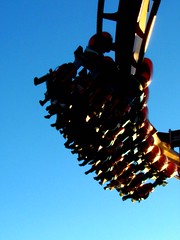
According to legend, there once was a time when demons and evil spirits stalked the plains of the west, and the only way to stop them was with a supernatural silver bullet from the Jacob Mining Co., located in parts north of the quaint town of Calico. Operated by a recluse known only as “Just Jacob”, the evil spirits eventually determined the source of the silver bullets and descended upon the town in force. Jacob, however, devised a contraption to outsmart the demons by creating powerful ore cars that were suspended beneath a floating track. The silver bullets could then be rushed through tunnels and caverns as gunslingers sat perched on benches protecting the precious cargo, and this eventually rid the town of its demons.
Thus I am informed by a sign in front of the main entrance for Silver Bullet, a bizarrely incongruous attempt at thematic back story to “explain the ride away”, despite the fact that I read this while a massive,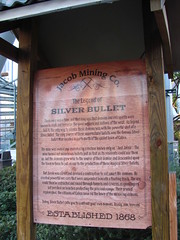 elevated transfer track platform blots the sun from view. Apart from the use of narrative on a laminated sign, there is no attempt to disguise Silver Bullet. It is a roller coaster without subtly or humility. I guess words are cheaper than the cost of ordering more colors of paint than red and yellow. Or someone realized a few days before it opened that long time fans might raise issue with the fact that they were removing a significant section of Knott’s historic Ghost Town for a West Coast Raptor, and so found an intern who had taken a creative writing class in college so she got a break from running coffee for an afternoon.
elevated transfer track platform blots the sun from view. Apart from the use of narrative on a laminated sign, there is no attempt to disguise Silver Bullet. It is a roller coaster without subtly or humility. I guess words are cheaper than the cost of ordering more colors of paint than red and yellow. Or someone realized a few days before it opened that long time fans might raise issue with the fact that they were removing a significant section of Knott’s historic Ghost Town for a West Coast Raptor, and so found an intern who had taken a creative writing class in college so she got a break from running coffee for an afternoon.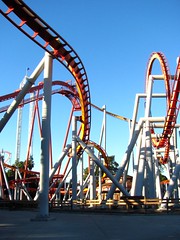
Several miles away, Scream would go down in history for being the worst example of a “parking lot roller coaster”, but one look at Knott’s Silver Bullet and I determined that it takes only a bare minimum of effort to appease the theme park foamers into overlooking a far greater crime against good taste. Yes, it has a more ‘natural’ location than Scream, over the former Reflection Lake. No, it doesn’t do much reflecting today with all the concrete footers strewn throughout. But what is a body of water to a roller coaster designer other than a flat, open construction arena with a minimum of obstacles complicating the engineering process? CAD works way easier
location than Scream, over the former Reflection Lake. No, it doesn’t do much reflecting today with all the concrete footers strewn throughout. But what is a body of water to a roller coaster designer other than a flat, open construction arena with a minimum of obstacles complicating the engineering process? CAD works way easier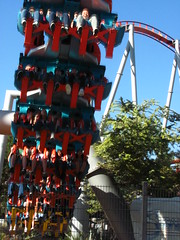 when you don’t have to figure in annoying things like a preexisting environment. In short, Silver Bullet is a sincere attempt to be as much of a parking lot coaster as it can. At least Scream is hidden in the back corner of the park where you can easily ignore it if you want to, and I doubt anyone will shed a tear over the loss of their once beautiful car park. Silver Bullet is the worse offender.
when you don’t have to figure in annoying things like a preexisting environment. In short, Silver Bullet is a sincere attempt to be as much of a parking lot coaster as it can. At least Scream is hidden in the back corner of the park where you can easily ignore it if you want to, and I doubt anyone will shed a tear over the loss of their once beautiful car park. Silver Bullet is the worse offender.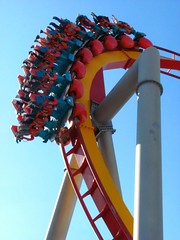
They couldn’t even be bothered to paint it silver. (I’m not counting the supports because, if the legend is true, the track is really floating and those supports are nothing more than an enigma projected by a tricky demon.) The carnivalesque red and yellow track and cars are far less evocative of a western color palate than Cedar Fair seems to think. That is assuming they were unaware that choosing such a bright selection made an already visually intrusive structure hold a total monopoly on attention in the area. Our “Flying Ore Carts” are obviously identified by a WTF ensemble of teal, yellow and orange-red. In the one solitary spastic jism of creativity, the last three of eight vehicles per train were turned yellow, and the lift and its supports are a blanket red… I assume the aesthetic logic being ‘cause it’d look retarded if it were all uniformly the same style of tacky.
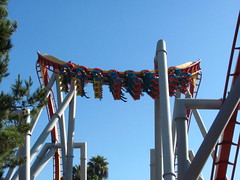 As with any B&M coaster there is a formal elegance to the track, but this is generally undone by the oversized steel supports that clutter the scene. These are all dissonant, hard angles, purely functional in design; why no more radial triangles? For example, the cobra roll over the entrance midway might have had a pleasant symmetry to it if the arbitrary double-sided support on the right didn’t mess it up. Yes that is minor nitpicking, but if anyone were actually responsible for asking if there was any coherent visual strategy to the way this high-end fairground attraction would compete for an audience’s attention (which, with its centralized location near the entrance over a former viewing pond, is a big audience), there shouldn’t have been any obvious, easily correctable nits to pick.1
As with any B&M coaster there is a formal elegance to the track, but this is generally undone by the oversized steel supports that clutter the scene. These are all dissonant, hard angles, purely functional in design; why no more radial triangles? For example, the cobra roll over the entrance midway might have had a pleasant symmetry to it if the arbitrary double-sided support on the right didn’t mess it up. Yes that is minor nitpicking, but if anyone were actually responsible for asking if there was any coherent visual strategy to the way this high-end fairground attraction would compete for an audience’s attention (which, with its centralized location near the entrance over a former viewing pond, is a big audience), there shouldn’t have been any obvious, easily correctable nits to pick.1
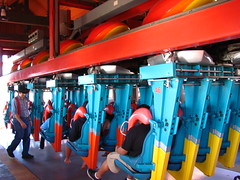
 ‘Tis a shame my analysis had to start off this way, because in spite of it all there’s a track layout that is slightly better than that of the average inverted roller coaster… although not one that’s so compelling that I forgive it of the sin of vandalizing a once venerated piece of property in the history of theme parks. The first drop is often ostracized by enthusiasts for being very short and shallow.
‘Tis a shame my analysis had to start off this way, because in spite of it all there’s a track layout that is slightly better than that of the average inverted roller coaster… although not one that’s so compelling that I forgive it of the sin of vandalizing a once venerated piece of property in the history of theme parks. The first drop is often ostracized by enthusiasts for being very short and shallow. I for one appreciated the sense of accumulating speed and rushing towards the vertical loop that you don’t get as easily from steeper declines,
I for one appreciated the sense of accumulating speed and rushing towards the vertical loop that you don’t get as easily from steeper declines,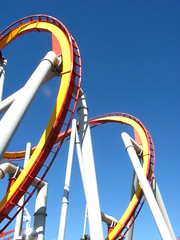 although I would have preferred had it gone all the way and didn’t pull up with 30 feet of clearance still remaining. The vertical loop is serviceable, but so overused I have to concentrate during the inversion to remember it more than ten seconds later. This is made more difficult in light of the next maneuver, a severely overbanked turn, the first and still only such element on a B&M inverted coaster. We rotate much further than the dynamics of this broad curve necessitate so we’re halfway to weightlessness in addition to being halfway upside down. It also has the advantage of falling further on the exit than it went up on the entrance due to the prior elevated loop, and I’m surprised and pleased our roar into maximum speed
although I would have preferred had it gone all the way and didn’t pull up with 30 feet of clearance still remaining. The vertical loop is serviceable, but so overused I have to concentrate during the inversion to remember it more than ten seconds later. This is made more difficult in light of the next maneuver, a severely overbanked turn, the first and still only such element on a B&M inverted coaster. We rotate much further than the dynamics of this broad curve necessitate so we’re halfway to weightlessness in addition to being halfway upside down. It also has the advantage of falling further on the exit than it went up on the entrance due to the prior elevated loop, and I’m surprised and pleased our roar into maximum speed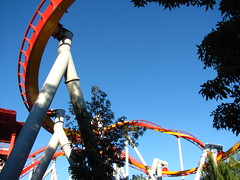 is delayed a full two elements after the main drop.
is delayed a full two elements after the main drop.
The cobra roll is generally one of the better elements in B&M’s catalogue due to the varied pacing and rotation around the top, and shows up in fine form here. Set above an arterial midway, it could have been an icon for the park if they wanted, but the botched visual design outlined above means that it’s just incidentally there. The follow-up zero G roll is another relatively fun element for the same generic reasons, this one slightly differentiated by continuing the fast rotation of the inversion directly into the inclined helix that follows. This acts as a midpoint for the layout, starting the second half with a rapid succession of reasonably intense flat-spin, overbank twist, and reverse flat-spin.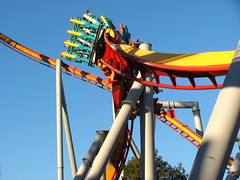 There’s a continuous flow to this sequence I wish more B&M rides had, as I was surprised by how much I liked this arrangement of otherwise familiar elements.
There’s a continuous flow to this sequence I wish more B&M rides had, as I was surprised by how much I liked this arrangement of otherwise familiar elements.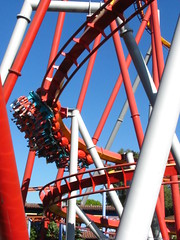
The helix finale I found odd, because while riding it I was actively thinking that the positive G-forces didn’t seem anywhere beyond normal force envelopes, but as soon as it was over I experienced ‘heavy feet’, with that prickling sensation around my socks due to all the blood rushing downward in my legs.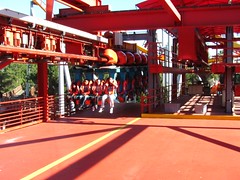 This repeated on my next few re-rides, and after browsing a few reviews online I gathered this was not an uncommon phenomenon. The real question was how it could seem less forceful than it really was. My guess is a lot of the sense of force is psychological rather than merely physiological, and Silver Bullet has high G-forces but doesn’t know how to accent them so we fully realize they’re there. The entrance continues directly from the prior flat spin so there’s no snap to announce the arrival of the positives, and the upward spiral means that the inner ear more keenly senses the relative decreasing in speed and force rather than their
This repeated on my next few re-rides, and after browsing a few reviews online I gathered this was not an uncommon phenomenon. The real question was how it could seem less forceful than it really was. My guess is a lot of the sense of force is psychological rather than merely physiological, and Silver Bullet has high G-forces but doesn’t know how to accent them so we fully realize they’re there. The entrance continues directly from the prior flat spin so there’s no snap to announce the arrival of the positives, and the upward spiral means that the inner ear more keenly senses the relative decreasing in speed and force rather than their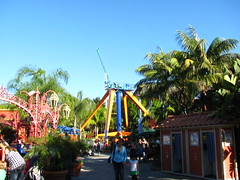 absolute values. It certainly didn’t leave nearly as strong an impression on me as Raptor’s descending double helix, even though the physiological sensations were much stronger. (The brakes are last.)
absolute values. It certainly didn’t leave nearly as strong an impression on me as Raptor’s descending double helix, even though the physiological sensations were much stronger. (The brakes are last.)
 Around the corner behind Silver Bullet, Knott’s demonstrates that they are capable of integrating a high density of thrill rides and not have it come off as poorly conceived in their Fiesta Village. It perhaps helps that the zone is named for a colorful, convivial party town rather than a place where the last resident expired during the Hays administration; also maybe because most of the infrastructure and major attractions were built prior to 1997. The Mesoamerican environment is surprisingly beautiful for what could have otherwise been a carnival midway, filled with greenery, flowers, fountains and bright ornamentations. In addition to the new for 2011 Windseeker (not yet completed at the time of my visit), the other large flat ride of interest is La Revolución, a Chance Afterburner-type ride installed in 2004. There are also a carousel, wave swinger,
Around the corner behind Silver Bullet, Knott’s demonstrates that they are capable of integrating a high density of thrill rides and not have it come off as poorly conceived in their Fiesta Village. It perhaps helps that the zone is named for a colorful, convivial party town rather than a place where the last resident expired during the Hays administration; also maybe because most of the infrastructure and major attractions were built prior to 1997. The Mesoamerican environment is surprisingly beautiful for what could have otherwise been a carnival midway, filled with greenery, flowers, fountains and bright ornamentations. In addition to the new for 2011 Windseeker (not yet completed at the time of my visit), the other large flat ride of interest is La Revolución, a Chance Afterburner-type ride installed in 2004. There are also a carousel, wave swinger,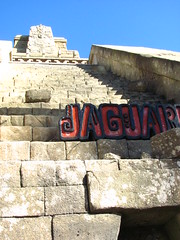 and a Mexican Hat Dance teacup-style flat. And then there are the roller coasters.
and a Mexican Hat Dance teacup-style flat. And then there are the roller coasters.
Jaguar is particularly impressive, a large temple guarding the entrance with the queue winding through several dark sections of catacombs before terminating in the station platform, bearing more favorable than negative comparison to Dueling Dragons or Indiana Jones. Too bad this kitty never quite lives up to the promise of excellence in the queue. This coaster is more or less the mine train the park never had, with its long meandering layout and family friendly age range. However, the Zierer Tivoli system doesn’t quite capture the same feel as the classic Arrow mine train, perhaps owing to the snug fitting lilliputian vehicles and whiny tire drive lifts. It is also at a lack of any steep drops, and with the ultralong train it chugs along the layout at an even, unvarying pace, robbing it of some of the fun and spontaneity of a true mine train; the arrival of a second lift hill halfway through the layout might barely draw distinction from the rest of the gravity-driven sections, and one occasionally wonders if the whole thing isn’t a powered coaster in disguise.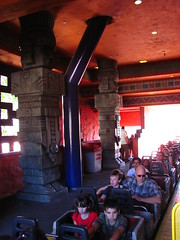
 I still found myself wanting to like Jaguar more than I actually did, because it had the quirky lovability of an independent label struggling to find a niche audience amid the corporate giants. The layout is paradoxically memorable for its unmemorability (I had no idea what was around the next corner or when it would end, and even after riding it I still don’t have a clue), although it obviously screams “shoehorning” at several points. Sometimes extremely clumsy shoehorning, like the long stretch of flat track built directly over the brake run and railroad tracks to bridge from one vacant lot to another, and a lot of track randomly erected
I still found myself wanting to like Jaguar more than I actually did, because it had the quirky lovability of an independent label struggling to find a niche audience amid the corporate giants. The layout is paradoxically memorable for its unmemorability (I had no idea what was around the next corner or when it would end, and even after riding it I still don’t have a clue), although it obviously screams “shoehorning” at several points. Sometimes extremely clumsy shoehorning, like the long stretch of flat track built directly over the brake run and railroad tracks to bridge from one vacant lot to another, and a lot of track randomly erected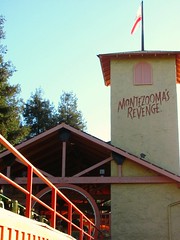 over concrete midways. Lucky for Cedar Fair they weren’t involved in the decision making process when Jaguar opened in ’95, otherwise I’d unfairly scapegoat them for these deficiencies just as readily as I have for everything else I’ve found distasteful in the park thus far.
over concrete midways. Lucky for Cedar Fair they weren’t involved in the decision making process when Jaguar opened in ’95, otherwise I’d unfairly scapegoat them for these deficiencies just as readily as I have for everything else I’ve found distasteful in the park thus far.
Montezooma’s Revenge is the most difficult roller coaster to find anything negative to say about, because it is a simple but effective classic that has remained nearly untouched by clueless lawyers’ recommendations since it opened in 1977. Apart from the paint selection and some new signage, the Schwarzkopf shuttle loop retains all the original architecture and the same flywheel technology with the cute but vicious little catchdog that scuttles over the launch track. And most importantly (take note, Magic Mountain!), it has the same open-air, lapbar-only vehicles and the absence of any braking until the second backward spike is completed and the train comes crashing back into the loading platform. Although permanently limited to one-train operation, the combination of a full-length seven vehicle train, a simple safety-bar check procedure, and a short ride time mean it might have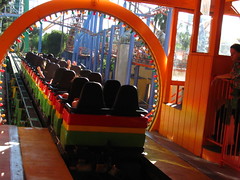 one of the highest throughputs in the park, depending on the location of GhostRider’s third train and the caffeine levels of the Silver Bullet crew. Even the most hardened theme park cynics would look bad arguing against such a ride, which depending on your attitudes towards
one of the highest throughputs in the park, depending on the location of GhostRider’s third train and the caffeine levels of the Silver Bullet crew. Even the most hardened theme park cynics would look bad arguing against such a ride, which depending on your attitudes towards everything else in Knott’s could make the Revenge the best ride in the park (though I’m still a loyalist to GhostRider). What’s strange about all of this love is that, at heart, Monty is certainly the shortest, and also potentially the least original layout at the Farm. Maybe it’s just an enthusiast bias
everything else in Knott’s could make the Revenge the best ride in the park (though I’m still a loyalist to GhostRider). What’s strange about all of this love is that, at heart, Monty is certainly the shortest, and also potentially the least original layout at the Farm. Maybe it’s just an enthusiast bias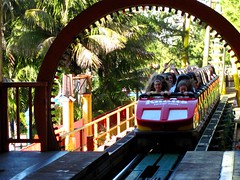 for unmodified Anton Schwarzkopf designs, but the smiles and laughter in the station (and scores of children running around the entrance to do it again) would suggest a deeper connection between coaster and rider than mere nostalgia.
for unmodified Anton Schwarzkopf designs, but the smiles and laughter in the station (and scores of children running around the entrance to do it again) would suggest a deeper connection between coaster and rider than mere nostalgia.
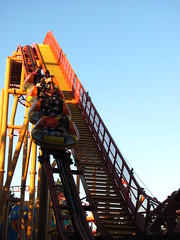 Knott’s Camp Snoopy is an area I doubt I would have spent very much time inside if the queue for the 2007 Sierra Sidewinder spinning coaster from Mack didn’t take so long. Along with the previous two roller coasters mentioned and the Pony Express from part one, Knott’s seems to be deliberately positioning themselves to appeal to the young thrill seekers, a populace that often gets neglected (or at the very least, overshadowed) in the world of theme and amusement parks. The only problem with this strategy is that while Knott’s has plenty in this category of Family Thrill Rides, none of them are particularly outstanding by their own merits. Neither Pony Express nor Jaguar are exactly what I’d call top-tier (one’s shorter than it should be, the other longer than it should be), and while Monty is popular, the purist in me is reluctant to classify that one as for the kiddies. Sierra Sidewinder is potentially the best-fitted for this label, but that didn’t mean I found it especially worth my own time.
Knott’s Camp Snoopy is an area I doubt I would have spent very much time inside if the queue for the 2007 Sierra Sidewinder spinning coaster from Mack didn’t take so long. Along with the previous two roller coasters mentioned and the Pony Express from part one, Knott’s seems to be deliberately positioning themselves to appeal to the young thrill seekers, a populace that often gets neglected (or at the very least, overshadowed) in the world of theme and amusement parks. The only problem with this strategy is that while Knott’s has plenty in this category of Family Thrill Rides, none of them are particularly outstanding by their own merits. Neither Pony Express nor Jaguar are exactly what I’d call top-tier (one’s shorter than it should be, the other longer than it should be), and while Monty is popular, the purist in me is reluctant to classify that one as for the kiddies. Sierra Sidewinder is potentially the best-fitted for this label, but that didn’t mean I found it especially worth my own time.
 The problem of low capacity with spinning coasters was given an attempted solution by utilizing a train of four linked cars rather than individual vehicles which require a block brake every ten seconds. This worked on the prototype at Europa Park, but here they were stacking the two trains so badly that it ended up having the longest wait of any attraction. This wasn’t helped by the fact that the employees were more interested in policing the riders than they were in dispatch times, twice triggering an e-stop on the lift just to reprimand some wiley teenagers. The layout’s alright, longer than Pony Express and with more purpose than Jaguar, it has a few good overbanked turns that are unusual for a spinning coaster and a nimble side-to-side S-bend. However, I was mostly distracted from these features due to the spinning cars,
The problem of low capacity with spinning coasters was given an attempted solution by utilizing a train of four linked cars rather than individual vehicles which require a block brake every ten seconds. This worked on the prototype at Europa Park, but here they were stacking the two trains so badly that it ended up having the longest wait of any attraction. This wasn’t helped by the fact that the employees were more interested in policing the riders than they were in dispatch times, twice triggering an e-stop on the lift just to reprimand some wiley teenagers. The layout’s alright, longer than Pony Express and with more purpose than Jaguar, it has a few good overbanked turns that are unusual for a spinning coaster and a nimble side-to-side S-bend. However, I was mostly distracted from these features due to the spinning cars,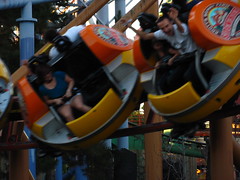 which didn’t spin but just had me facing random angles that made it more difficult to tell exactly what was going on. My vehicle didn’t rotate more than 180° from its starting position, only finally managing a complete rotation on the banking snap into the brake run. And this was as a single rider in an unevenly weighted car. My sour opinion was mostly caused by the long wait cutting into the evening hours when I haven’t even completed a first loop of the major rides yet, so I’ll give it a second chance on a day when I have more time to waste.
which didn’t spin but just had me facing random angles that made it more difficult to tell exactly what was going on. My vehicle didn’t rotate more than 180° from its starting position, only finally managing a complete rotation on the banking snap into the brake run. And this was as a single rider in an unevenly weighted car. My sour opinion was mostly caused by the long wait cutting into the evening hours when I haven’t even completed a first loop of the major rides yet, so I’ll give it a second chance on a day when I have more time to waste.
Crossing the train tracks, I found myself walking upon the Boardwalk; a 1950’s California styled collection of thrill rides and nostalgia that unfortunately smacks of the most clichéd and overused theme of any section in Knott’s.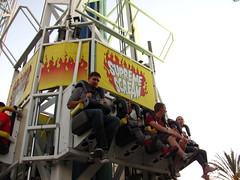 If they’ve got their history right, the economy of 1950’s America was motivated exclusively by diners and gas stations, along with the occasional surf shop on the progressive west coastline. This area was previously known as the Roaring 20’s when the actual 1950’s were
If they’ve got their history right, the economy of 1950’s America was motivated exclusively by diners and gas stations, along with the occasional surf shop on the progressive west coastline. This area was previously known as the Roaring 20’s when the actual 1950’s were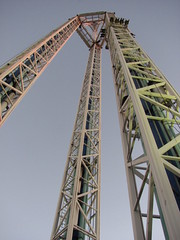 still less than two decades young, which makes me ponder if we won’t soon be seeing it rethemed again in a few years to a time when the nation had an Atari console and legwarmer based economy. Anyway, the first attraction I found was the Supreme Scream, a triple-sided 250 foot tall S&S Turbo Drop, and one that I was more than happy to ride when I found an empty queue. However, life is short and there’s nothing to be said about this drop tower that hasn’t been said about every other equally 1-dimensional tower ride. So I’ll make better use of the time you would have otherwise spent learning nothing new about faster-than-freefall acceleration by sharing a laugh instead. In the video below the cinematic legend Orson Welles attempts to film a commercial for a California winemaker after sampling the product he’s endorsing.
still less than two decades young, which makes me ponder if we won’t soon be seeing it rethemed again in a few years to a time when the nation had an Atari console and legwarmer based economy. Anyway, the first attraction I found was the Supreme Scream, a triple-sided 250 foot tall S&S Turbo Drop, and one that I was more than happy to ride when I found an empty queue. However, life is short and there’s nothing to be said about this drop tower that hasn’t been said about every other equally 1-dimensional tower ride. So I’ll make better use of the time you would have otherwise spent learning nothing new about faster-than-freefall acceleration by sharing a laugh instead. In the video below the cinematic legend Orson Welles attempts to film a commercial for a California winemaker after sampling the product he’s endorsing.
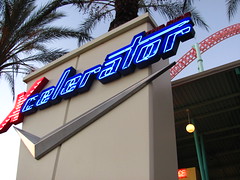 Mwahaaaa, the Swiss roller coasters have always been celebrated for their excellence. Of the California coasters, Xcelerator is one of their most xcellent. Looking back, I’m surprised it didn’t make more of a stir in the enthusiast community than it did when first unveiled. It had no more fanfare than an average coaster announcement, just a simple press release and watercolor rendering that told us Knott’s was building another roller coaster. I remember it took a while of looking at the simple artist’s rendering before it hit me what a revolutionary concept this actually was, the 80 mph launch into a vertical 200+ foot spike with 90° heartline twists on the way up and down. I guess the perception was that Intamin was riding on the S&S Thrust Air 2000’s coattails, and the vertical twists were merely an inverse of Premier’s already half-decade
Mwahaaaa, the Swiss roller coasters have always been celebrated for their excellence. Of the California coasters, Xcelerator is one of their most xcellent. Looking back, I’m surprised it didn’t make more of a stir in the enthusiast community than it did when first unveiled. It had no more fanfare than an average coaster announcement, just a simple press release and watercolor rendering that told us Knott’s was building another roller coaster. I remember it took a while of looking at the simple artist’s rendering before it hit me what a revolutionary concept this actually was, the 80 mph launch into a vertical 200+ foot spike with 90° heartline twists on the way up and down. I guess the perception was that Intamin was riding on the S&S Thrust Air 2000’s coattails, and the vertical twists were merely an inverse of Premier’s already half-decade old Mr. Freeze coasters. But Intamin made it work in a way that none of their predecessors were able to do, and for better or worse Xcelerator set the agenda for the Swiss firm for most of the decade that followed (possibly at the expense of their traditional gravity-driven megacoasters that mostly dropped off the map after 2002).
old Mr. Freeze coasters. But Intamin made it work in a way that none of their predecessors were able to do, and for better or worse Xcelerator set the agenda for the Swiss firm for most of the decade that followed (possibly at the expense of their traditional gravity-driven megacoasters that mostly dropped off the map after 2002).
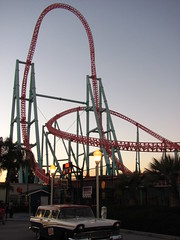 Closing in on a decade later, Xcelerator remains just as easy to overlook, but as Knott’s headlining thrill ride that goes toe-to-toe with the big dogs at Magic Mountain it retains a devout following amid the Los Angeles home base.
Closing in on a decade later, Xcelerator remains just as easy to overlook, but as Knott’s headlining thrill ride that goes toe-to-toe with the big dogs at Magic Mountain it retains a devout following amid the Los Angeles home base.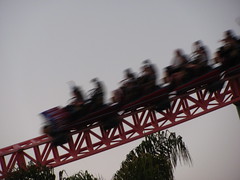 While the rocket coaster design evolved into considerably more ambitious or complex designs, there’s a raw crudeness to Xcelerator that has never been replicated in newer models. The absence of any over the shoulder restraints, the launch directly out of the station loading platform with extremely little warning, and the crest
While the rocket coaster design evolved into considerably more ambitious or complex designs, there’s a raw crudeness to Xcelerator that has never been replicated in newer models. The absence of any over the shoulder restraints, the launch directly out of the station loading platform with extremely little warning, and the crest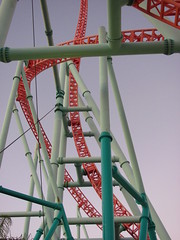 over the top hat remains the most regularly overspeed of its type. The visual appearance is no more subtle than Silver Bullet’s, but the pink and teal structure is at least at home amid the other razzmatazz amusements on the 50’s boardwalk, and a preponderance of neon and chrome with the detailed Chevy fiberglass casings look good with the massive steel columns. A gigantic parabolic arch suspended in midair with the triangular stepladder supports on either side is also iconographic in a way that’s missing from Silver Bullet’s signature cobra roll. Besides, the location is set along a highway bordering the back of the park, and it only dislocated a much lamer freakshow coaster, so Knott’s lost nothing and gained everything with the addition of Xcelerator. A word of warning for first time visitors, the queue for the front car starts far away from the station and is poorly marked with no advisories to the extra wait time. As a result, the right side of the division will generally fill with an hour or more worth of folks who just get in whatever line they see people in, while the seating for cars 2 thru 5 on the left can be briskly walked up and in ready to launch position within five minutes.
over the top hat remains the most regularly overspeed of its type. The visual appearance is no more subtle than Silver Bullet’s, but the pink and teal structure is at least at home amid the other razzmatazz amusements on the 50’s boardwalk, and a preponderance of neon and chrome with the detailed Chevy fiberglass casings look good with the massive steel columns. A gigantic parabolic arch suspended in midair with the triangular stepladder supports on either side is also iconographic in a way that’s missing from Silver Bullet’s signature cobra roll. Besides, the location is set along a highway bordering the back of the park, and it only dislocated a much lamer freakshow coaster, so Knott’s lost nothing and gained everything with the addition of Xcelerator. A word of warning for first time visitors, the queue for the front car starts far away from the station and is poorly marked with no advisories to the extra wait time. As a result, the right side of the division will generally fill with an hour or more worth of folks who just get in whatever line they see people in, while the seating for cars 2 thru 5 on the left can be briskly walked up and in ready to launch position within five minutes.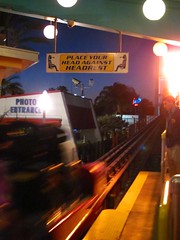
 Part of me wishes for the prolonged, multi-part suspense of a launch initiation such as on Top Thrill Dragster to squeeze out as much tension before a sixteen second ride as possible (first slowly clear the station, then wait in the standby position for the first train to launch, then crawl up into the real launch pad, wait for the cable catch to reload and the last block to clear, the countdown, etc.). But there is something much more shocking about sitting in neutral the station, the eager onlookers behind the gates you were just standing behind still within easy conversational speaking distance, and without any preparation being blasted
Part of me wishes for the prolonged, multi-part suspense of a launch initiation such as on Top Thrill Dragster to squeeze out as much tension before a sixteen second ride as possible (first slowly clear the station, then wait in the standby position for the first train to launch, then crawl up into the real launch pad, wait for the cable catch to reload and the last block to clear, the countdown, etc.). But there is something much more shocking about sitting in neutral the station, the eager onlookers behind the gates you were just standing behind still within easy conversational speaking distance, and without any preparation being blasted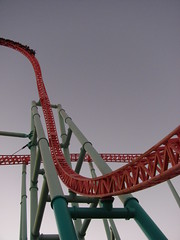 back into the headrest at blistering speeds and then catapulted into an angel eye’s view down upon Buena Park in the space of about five seconds. You feel a much closer immediacy to the experience, like watching a deadly animal without any protective barriers between the two of you.
back into the headrest at blistering speeds and then catapulted into an angel eye’s view down upon Buena Park in the space of about five seconds. You feel a much closer immediacy to the experience, like watching a deadly animal without any protective barriers between the two of you.
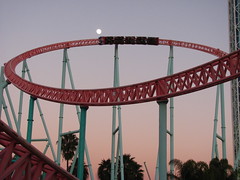 From my couple of rides, the negative G’s were consistently strong over the entire arch, with none of the momentary settling back down into the seat at the top that the later rocket coasters have their hydraulic motors tuned for. I will probably not be the very first person to mention that after the top hat the overbanked figure eight is unnecessary and basically only serves the purpose to extend the ride long enough such that the second train
From my couple of rides, the negative G’s were consistently strong over the entire arch, with none of the momentary settling back down into the seat at the top that the later rocket coasters have their hydraulic motors tuned for. I will probably not be the very first person to mention that after the top hat the overbanked figure eight is unnecessary and basically only serves the purpose to extend the ride long enough such that the second train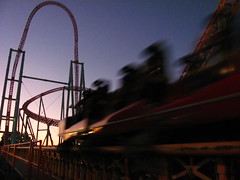 has at least has time to make it into the station before the first is re-entering the brakes. Nevertheless, the coaster does need something after the tower to flesh it out (Stealth and Zaturn are empty experiences by comparison), and with the small lot and inversions not possible without the addition of shoulder harnesses, I suppose this configuration is as good as we could have hoped for. I’m not a fan of overbanked turns on the Intamin megacoasters, but at 80 miles per hour on a small lot of land, even these have a bit more bite to them. We slide into the magnetic brakes completely lost of breath, our ‘57 Chevy having never once let up on the gas pedal since the lights turned green. Granted it was only twenty five seconds of breathlessness, but these days fewer coasters are able to leave me gasping in disbelief for that length of time at all.
has at least has time to make it into the station before the first is re-entering the brakes. Nevertheless, the coaster does need something after the tower to flesh it out (Stealth and Zaturn are empty experiences by comparison), and with the small lot and inversions not possible without the addition of shoulder harnesses, I suppose this configuration is as good as we could have hoped for. I’m not a fan of overbanked turns on the Intamin megacoasters, but at 80 miles per hour on a small lot of land, even these have a bit more bite to them. We slide into the magnetic brakes completely lost of breath, our ‘57 Chevy having never once let up on the gas pedal since the lights turned green. Granted it was only twenty five seconds of breathlessness, but these days fewer coasters are able to leave me gasping in disbelief for that length of time at all.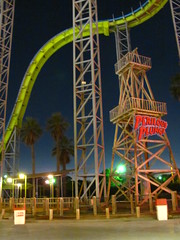
Once I had grabbed a couple of laps on Xcelerator, I moved on to the rest of the Boardwalk to complete my tour of the park right as the sun dipped below the western horizon. At the time of my visit, the area beyond the Coasters Drive-In would have been more deserving of the Ghost Town title. Perilous Plunge was closed for a repainting that would take the better part of the year, and the Sky Cabin still sat suspended in silence despite being given a stay of execution once the Windseeker project was relocated to Fiesta Village.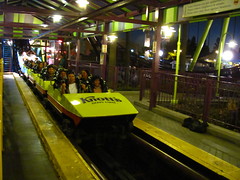 Rip Tide, the floorless HUSS Top Spin, was also off the table for me due to its many drenching water jets… I might have been in sunny California, but for me it was still the middle of January at night. This left the Boomerang as the last attraction I would sample. Normally I’m pretty precise about the order of attractions I rides so my day has a tidy narrative to it, but time somehow slipped away from me and so it was the Vekoma clone that would do the honors of wrapping up my review:
Rip Tide, the floorless HUSS Top Spin, was also off the table for me due to its many drenching water jets… I might have been in sunny California, but for me it was still the middle of January at night. This left the Boomerang as the last attraction I would sample. Normally I’m pretty precise about the order of attractions I rides so my day has a tidy narrative to it, but time somehow slipped away from me and so it was the Vekoma clone that would do the honors of wrapping up my review:
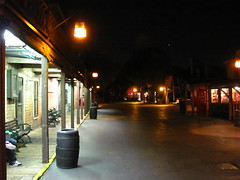 Uhh… I didn’t absolutely hate it? No, really, there was a time when I was getting on board when I reflected how glad I was to be alive in this moment in history. And that was much more a genuine reflection of how fortunate I was to be given a chance to live today’s experiences, rather than in horror of its potential termination at the end of a Vekoma-designed cobra roll. Nevertheless, I wouldn’t mind seeing the end of this Boomerang’s life and the installation of something like an S&S El Loco (an eight-seater model, like the one going into Australia) in its place. The purple and lime green track does Knott’s few favors. After I was done, I went to finish the final hour with two stellar front seat rides on GhostRider, and that was without question the wisest way to conclude the day.
Uhh… I didn’t absolutely hate it? No, really, there was a time when I was getting on board when I reflected how glad I was to be alive in this moment in history. And that was much more a genuine reflection of how fortunate I was to be given a chance to live today’s experiences, rather than in horror of its potential termination at the end of a Vekoma-designed cobra roll. Nevertheless, I wouldn’t mind seeing the end of this Boomerang’s life and the installation of something like an S&S El Loco (an eight-seater model, like the one going into Australia) in its place. The purple and lime green track does Knott’s few favors. After I was done, I went to finish the final hour with two stellar front seat rides on GhostRider, and that was without question the wisest way to conclude the day.
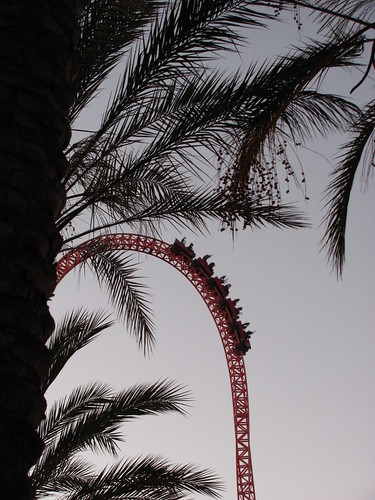
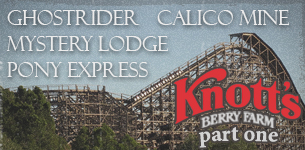
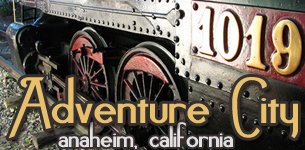
Footnotes and Annotations
[1] Just to prove that I can actually be constructive rather than another whiny blogger on an ego trip, I have a recommendation for Knott’s that could appease many of my qualms. The colors are starting to fade, and a repainting project should be due in a couple of years. Assuming their new CEO’s previous work experience will indicate a higher prioritization of visual pleasantries and thematic integration, I would suggest spending a few extra dollars on a new color scheme. Primarily on the supports, I would like to see the detailed “tree bark” look that’s starting to appear on some rides, such as Canobie Lake’s Untamed. Not even because I think it does a good job of disguising the supports as trees, but just because it adds a greater variety of texture to the mise-en-scène. A random mixture of birch, redwood and yellow pine to keep any one color impression from becoming too dominant when viewed from afar. Then for the track, I would like the current red to be replaced with a dark charcoal or gunmetal grey, and the current yellow to a highly reflective silver that will accent the beautiful twists and curves both at day and night, while more strongly emphasizing the coaster’s name. I spent a few minutes just standing by the reflecting pond trying to visualize any sort of color combination that could salvage some dignity for the northern side of Calico Ghost Town, and that was the solution that I think could best work. Please someone tell me I’m not the only one that thinks such a palate (or something similar) would be a dramatic improvement over the current look of the ride?
Spot on Jeremy! Too few companies give any thought (or money) to appearance but I am of the opinion that if you make a ride or attraction look attractive and natural within its environment you are more likely to encourage people to ride it, or even simply to want to come to the park. A great environment encourages repeat visits even from those who aren’t overly keen on riding the extreme stuff. Positive PR is worth a fortune and people always respond to a good look. ‘Wow that looks great’ often leads to ‘Got to ride it!’. Less so if your reaction on seeing said attraction is ‘Gee, that looks kind of crappy…’
The thing is, the failure to add a lot of scenery and landscaping elements to a ride is usually not simply due to inconsideration. If you look at the budgets for rides that do have a lot of that stuff, you’ll notice it’s not cheap for them, with stuff like show buildings easily doubling the cost. Uneven natural terrain can even drive up the expense beyond what you’d expect for simply building something on a hill.
But what kills me is when they can’t even at least be imaginative with their paint selection. That really shouldn’t be a matter of cost savings, unless mixing colors other than the basic primaries is really that much more complex and involved. I mean, Silver Bullet has a pretty imaginative color combo for a kindergarten coloring book, but I get the feeling the selection committee for the ride’s colors spent not even a fraction of the time looking over swatches for their $16,000,000 roller coaster than most homeowners do on a $300 bedroom repainting project. The range and contrast and hues that parks paint their roller coasters is always so predictably generic, and that to me should be the one area where I’d expect they could cut loose and have some fun without any worries about budget. It’s made worse when the ride is highly visible and those random choice of colors ends up defining the entire park.
ANY palate would bring a dramatic improvement to Silver Bullet’s current look. Like my grandmother might say, applying your suggested color scheme would be “too much like right.”